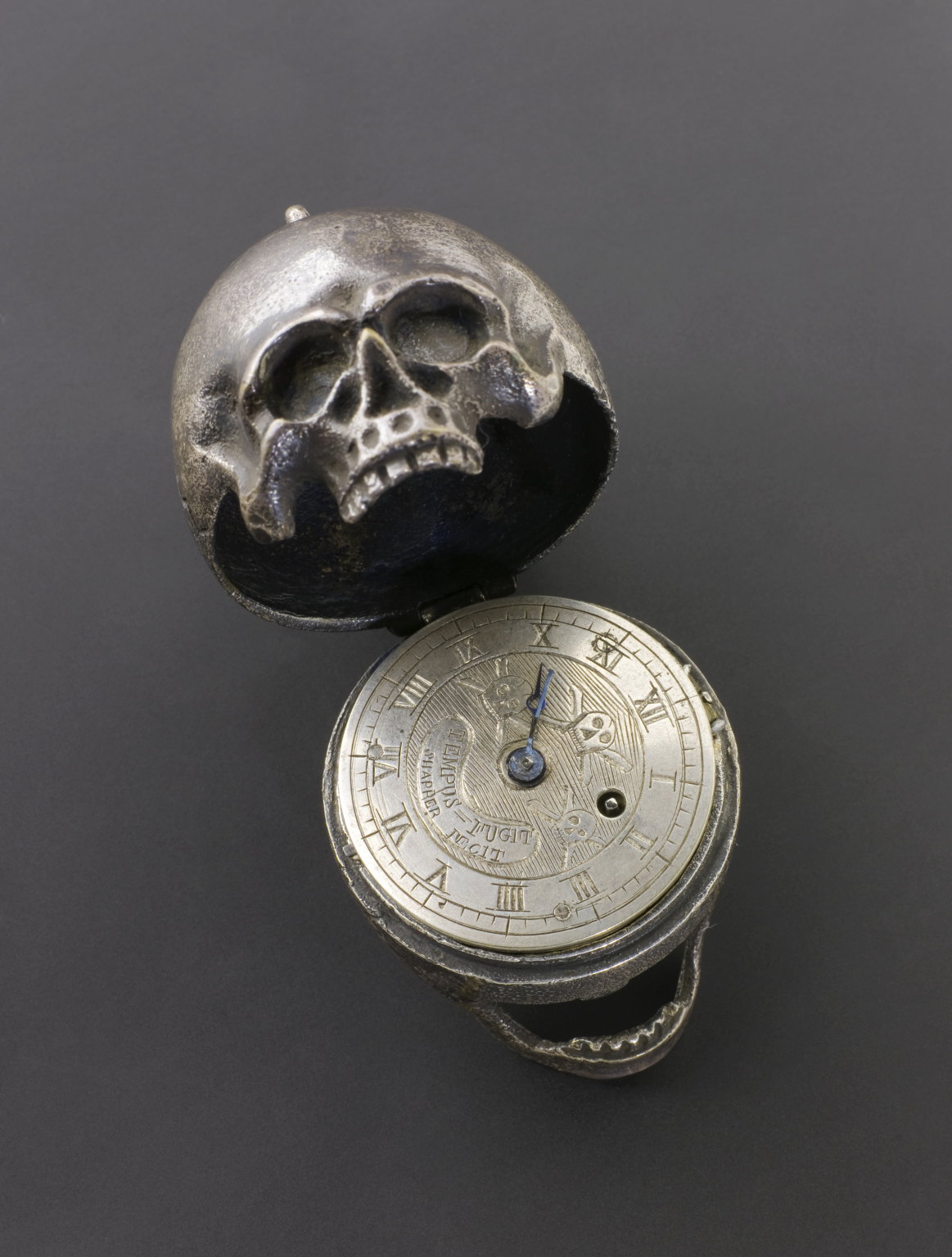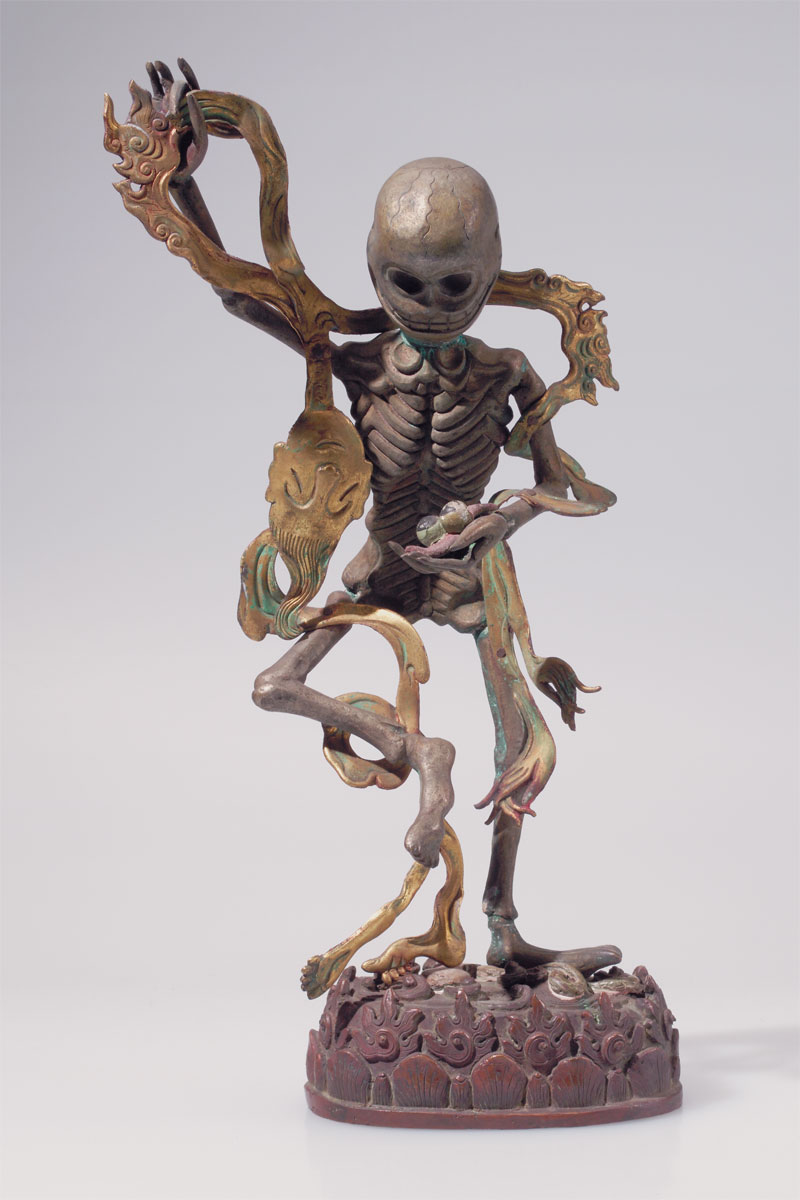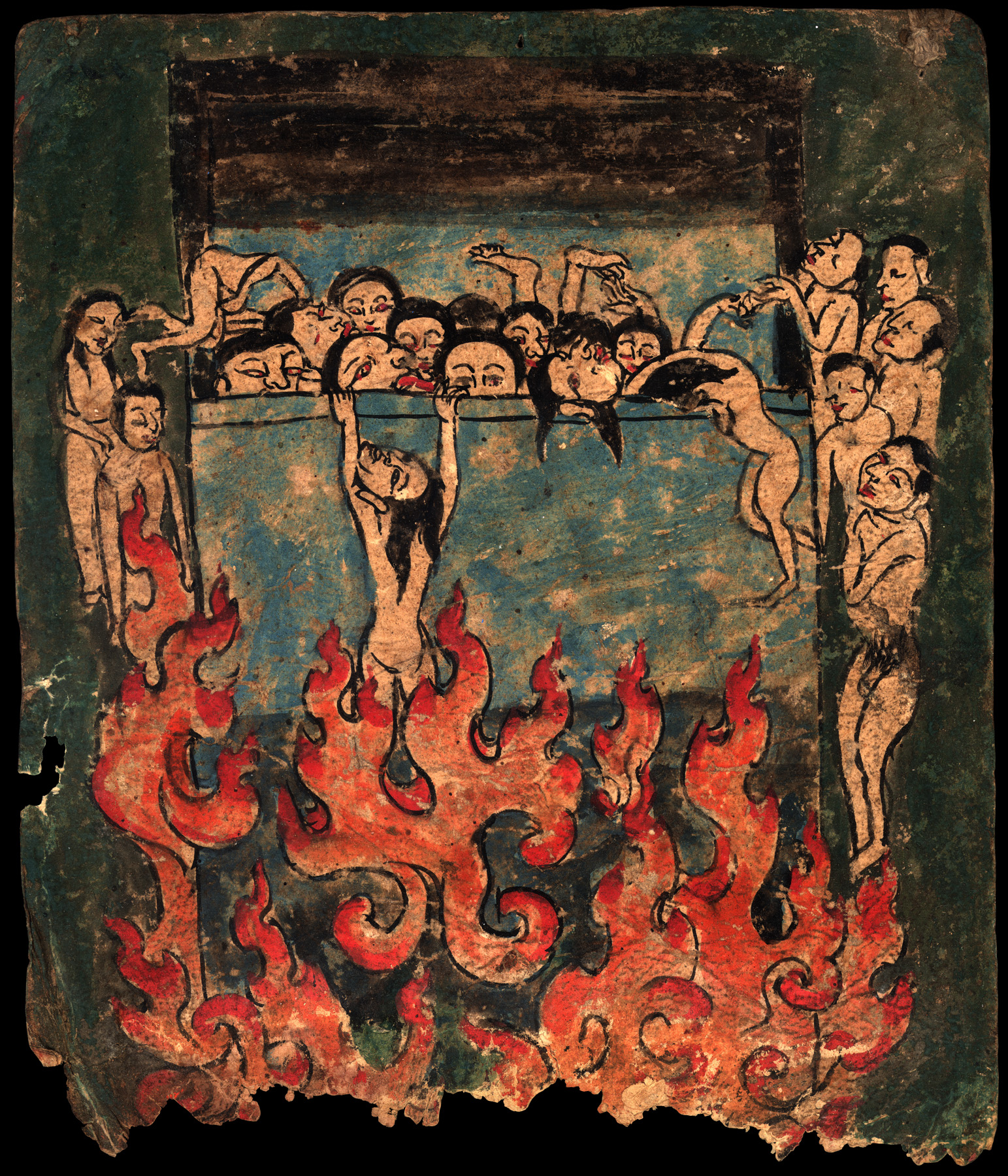


Eerie personifications of death greet the visitor in the form of two pairs of sculptures of skeleton figures: weathered lindenwood figures from 17th-century Germany extend bony, beckoning hands, while macabre bronzes from Tibet portray a yogic brother and sister engrossed in a mad dance—as skin peels off like furled ribbons. Both sculptural pairs warn of the fleeting nature of life: in the Western tradition, as memento mori, and in the Tibetan Buddhist tradition, as an incentive to make diligent use of precious human rebirth...I just found out about an excellent sounding exhibition on view through August 9th at the Rubin Museum in New York City. Entitled "Remember That You Will Die: Death Across Cultures," the exhibition seeks to explore the "fascinating parallels and significant differences in the depiction of death over the centuries...focusing on works of art from Medieval and Early Renaissance Europe and Tibet."
It seems that the curators for this exhibition have cast a refreshingly broad net in their search for artifacts; the exhibition includes objects drawn from the American Museum of Natural History, London's Wellcome Collection, the Harvard Museum or Art and the New York Public Library as well as from the Rubin's permanent collection. I am incredibly curious to see this show and hope to see more broad, multi-disciplinary shows like this one in this museum's future!
Full details, from the press release:
Remember That You Will Die: Death Across CulturesFor more about this exhibition, visit the Rubin Museum webpage by clicking here. Click on images to see much larger, more detailed versions. And thanks so much, Pam, for letting me know about this show!
The Rubin Museum of Art finds fascinating parallels and significant differences in the depiction of death over the centuries in "Remember That You Will Die," an exhibition focusing on works of art from Medieval and Early Renaissance Europe and Tibet.
Serving as memento mori (death remembrances), the 84 works of art and artifacts on view range from a 12th-century be-jeweled bronze reliquary arm from Belgium to a wooden club carved into the shape of a skeleton from Tibet. The one contemporary work, a video by the American artist Bill Viola entitled The Three Women, is being exhibited in New York for the first time.
Eerie personifications of death greet the visitor in the form of two pairs of sculptures of skeleton figures: weathered lindenwood figures from 17th-century Germany extend bony, beckoning hands, while macabre bronzes from Tibet portray a yogic brother and sister engrossed in a mad dance—as skin peels off like furled ribbons. Both sculptural pairs warn of the fleeting nature of life: in the Western tradition, as memento mori, and in the Tibetan Buddhist tradition, as an incentive to make diligent use of precious human rebirth.
“We have found one common denominator in the works of art we have gathered for Remember That You Will Die: whether from Europe or Tibet, all serve as reminders to the righteous that life is transient and volatile and that the believer must adhere to religious guidelines in order to safeguard a better hereafter,” says Martin Brauen, chief curator, Rubin Museum of Art. Dr. Brauen has organized the exhibition in collaboration with Karl Debreczeny, senior curator, Rubin Museum of Art, and Bonnie B. Lee, curatorial consultant.
Among the subjects found in the section of the presentation devoted to Western works are the danse macabre, or Dance of Death, and heaven, purgatory, and hell; among the Buddhist works, the landscape of the afterlife, whether it be paradise or hell, and brutal scenes of charnel grounds (considered ideal places to confront the fear of death through meditation).
"Remember That You Will Die" is to be shown concurrently at the Rubin Museum of Art with Bardo (February 12 through September 6, 2010), an exhibition, named for the intermediate state between death and enlightenment or rebirth in Tantric Buddhism, featuring works of art that have been used for centuries to prepare the initiate for death.
Exhibition Highlights
A number of the featured objects in "Remember That You Will Die" draw from popular folk traditions reflecting the societal preoccupation with death in Europe in the wake of The Black Death (14th century). Among these is The Dance of Death (1538), an engraving by Hans Holbein the Younger, depicting the danse macabre, an allegory for death not found in the Bible but acted out in plays and painted in church frescoes across the European continent to prompt Christian believers into piety as a way to guarantee salvation. Here, Holbein shows a peddler going along a country road with his wares as Death drags him in the opposite direction—to the underworld— while another Death figure in the shadows plays a long mandolin/violin-like bowed instrument, with his back turned to the peddler. Death, especially in the danse macabre form, often is seen to dance gaily and/or play musical instruments.
Two rosaries and two scrolls demonstrate the manner in which Christian and Buddhist works can take intriguingly similar forms. Two rosaries are featured in the exhibition, one a 16th-century German example of intricately carved ivory beads in the shape of human skulls, the other a 19th- century Tibetan beads of 100 skull-shaped beads more abstractly and coarsely carved from human bone.
Created for the wall of a chapel in the Marienkirche in Lubeck, Germany, the Lubeck Dance of Death scroll is an eight-foot long engraving showing Death as the universal social equalizer. The engraving starts on the left showing the greatest ecclesiastical power on Earth, the Pope, headed toward Death, and goes all the way down to the farmer and peasant, a young boy, young maiden, and infant. The brightly colored Charnel Grounds scroll from 19th-century Tibet unfolds more than seven feet, depicting eight cemeteries and the faithful who go there to meditate. Because dead bodies are left out, not buried, in charnel grounds, there could be no starker reminder of mortality than the corpses, ogres, hungry ghosts, and zombies depicted here.
A Buddhist initiation card, ritual bone apron, painted skull hand drum, and shinbone trumpet are among other objects on view from Tibet, to be seen nearby such European artifacts as a pocket watch in the form of a silver skull, a silver gilt pendant in the shape of a coffin, containing a skeleton with a frog sitting on its chest, and a doctor’s walking stick with a skull-shaped knob.
Images, Top to bottom:
- Skull Pocket Watch, Europe; 1701-1900; Silver model of a human skull which opens up to show a pocket watch inside inscribed with skull and cross bone; Silver; Science Museum, London
- Lord of the Charnel Grounds; Tibet; ca early 19th century; Bronze, American Museum of Natural History
- Tsagli (Initiation Cards); Tibet; Date?; Pigments on paper, Rubin Museum of Art


4 comments:
The watch is amazing!!
Please keep up all the amazing work that you do.
Love the site.
Wish I could go to NY - sounds fascinating!
Oooh & I'm even in NY state - thanks for the heads-up! :D
Big exhibition in Paris
http://www.museemaillol.com/
"c'est la Vie !"
Death in art
Post a Comment